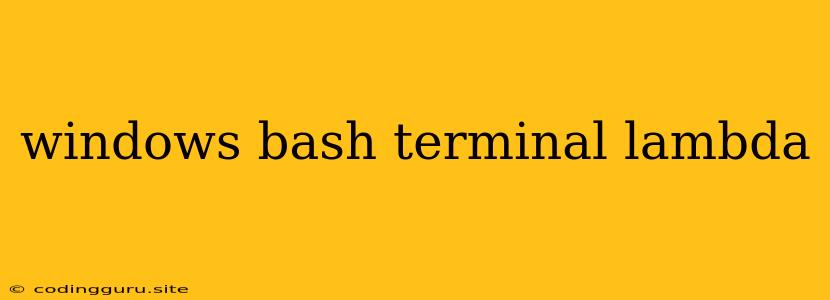Using the Windows Bash Terminal for AWS Lambda Development
Developing for AWS Lambda can be a powerful tool for building serverless applications. While the AWS console provides a web-based interface for managing and deploying Lambda functions, using a local development environment can be more efficient for coding, testing, and debugging. This is where the Windows Bash terminal comes in handy.
Why Choose the Windows Bash Terminal?
The Windows Bash terminal is a versatile environment that offers several benefits for Lambda development:
- Familiar Environment: If you are comfortable working with the command line, the Bash terminal provides a familiar interface for managing files, running commands, and interacting with your project.
- Cross-Platform Compatibility: The Bash terminal is available on various operating systems, including Windows, macOS, and Linux, which makes it easy to collaborate with developers using different platforms.
- Extensive Tools: The Bash terminal comes bundled with a wide range of tools, including text editors, package managers, and build tools that can streamline your development process.
- Integration with AWS Tools: Many AWS command-line tools are designed to work seamlessly with the Bash terminal, providing you with direct access to your AWS resources.
Setting Up the Windows Bash Terminal for Lambda Development
Before you can start developing Lambda functions using the Windows Bash terminal, you need to set up your environment. Follow these steps:
- Install the Windows Subsystem for Linux (WSL): WSL is a lightweight environment that runs a Linux distribution directly on Windows. This provides you with access to the Bash terminal and all its features.
- Choose a Linux Distribution: WSL supports various Linux distributions, such as Ubuntu, Debian, and Fedora. Select a distribution that meets your needs.
- Install AWS Tools: You can install AWS tools, such as the AWS Command Line Interface (AWS CLI) and AWS SDK for your chosen programming language, directly from the Bash terminal.
- Set Up a Virtual Environment: Creating a virtual environment is a good practice for managing project dependencies. Use tools like
virtualenvorcondato create isolated environments for your Lambda projects. - Configure Your IDE: Use a code editor or Integrated Development Environment (IDE) that supports Lambda development. Many popular IDEs, such as VS Code, have extensions and plugins that enhance your Lambda development workflow.
Developing Lambda Functions in the Windows Bash Terminal
Once your environment is set up, you can start developing your Lambda functions. Here are the steps involved:
- Create a Project Directory: Create a dedicated folder for your Lambda project to keep your code organized.
- Write Your Lambda Function Code: Choose a programming language supported by Lambda (such as Python, Node.js, Java, or Go) and write your Lambda function code in your chosen language.
- Define Your Dependencies: Use a package manager (e.g.,
pipfor Python ornpmfor Node.js) to install any required libraries or dependencies for your Lambda function. - Test Locally: Simulate the Lambda runtime environment locally to ensure your code works as expected. Tools like
sam localorserverless-offlinecan help you test your function without deploying it to AWS. - Deploy to AWS: Use the AWS CLI or other deployment tools to package your Lambda function code and deploy it to AWS.
Example: Python Lambda Function
Here's a simple example of a Python Lambda function using the Windows Bash terminal:
import json
def lambda_handler(event, context):
"""Sample Lambda function.
Args:
event (dict): The event that triggered the function.
context (object): The context object.
Returns:
dict: The response from the function.
"""
return {
"statusCode": 200,
"body": json.dumps("Hello from Lambda!")
}
Steps to Run the Function:
- Create a directory for your Lambda project.
- Create a Python file
lambda_function.pyand copy the code above. - Install the AWS CLI and configure your AWS credentials in the Windows Bash terminal.
- Package your function using
sam package:sam package --template-file template.yaml --output-template-file packaged.yaml - Deploy your function using
sam deploy:sam deploy --template-file packaged.yaml --stack-name my-lambda-stack --capabilities CAPABILITY_IAM - Test your deployed function using the AWS console or the AWS CLI.
Tips for Effective Lambda Development
- Use a Code Editor or IDE: A good code editor or IDE can provide features like syntax highlighting, auto-completion, debugging, and testing, making your Lambda development experience smoother.
- Leverage AWS Tools: Take advantage of AWS tools like the AWS CLI, AWS SDK, and SAM (Serverless Application Model) to manage your Lambda functions, resources, and deployments.
- Practice Infrastructure as Code (IaC): Use tools like CloudFormation or Terraform to define your Lambda function's resources, making your infrastructure more manageable and reproducible.
- Test Thoroughly: Test your Lambda functions extensively in both local and AWS environments to ensure they work as expected and handle various input scenarios.
- Optimize for Performance: Consider factors like code efficiency, resource allocation, and cold starts when optimizing your Lambda functions for better performance.
Conclusion
The Windows Bash terminal provides a powerful and flexible environment for developing Lambda functions. Its familiar interface, wide range of tools, and integration with AWS tools make it a great choice for serverless development. By following the tips and guidelines in this article, you can efficiently build and deploy Lambda functions that power your serverless applications.
